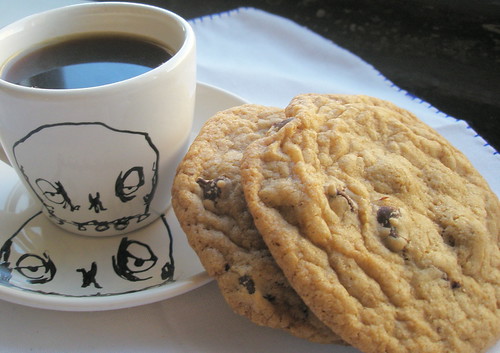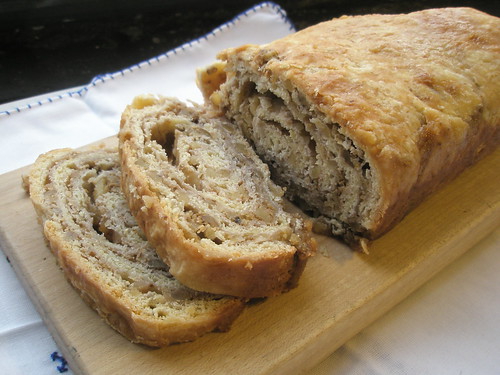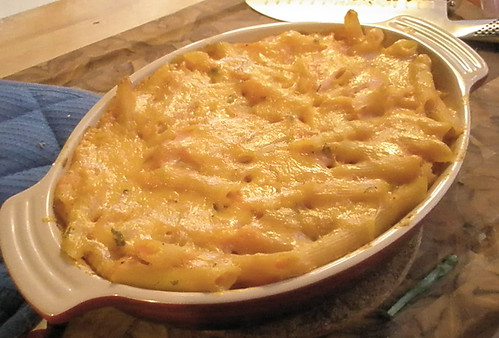If you ever wanted a good reason to join the Daring Bakers, look no further than the confection above. This is exactly why I signed up: to push my comfort level beyond cookies and cupcakes and into the realm of show-stopping centerpieces. And honestly? It isn't as hard as it looks. While the steps are numerous, this torte requires no esoteric flours or expensive equipment, just a little patience and Hungarian fluency. I kid! You can get by with 8th grade Hungarian.
The August 2009 Daring Bakers' challenge was hosted by Angela of
A Spoonful of Sugar and Lorraine of
Not Quite Nigella. They chose the spectacular Dobos Torte based on a recipe from Rick Rodgers' cookbook
Kaffeehaus: Exquisite Desserts from the Classic Cafés of Vienna, Budapest, and Prague. It's a Hungarian invention consisting of five sponge cake layers with a dark chocolate buttercream, topped with caramel-coated cake fans. According to
Le Wiki, there are over a hundred variations out there, so if you like this torte you could easily stay busy for the next several years trying them all.
Zsa Zsa Gabor: Eminent Hungarian
I've left in the metric amounts because lately I've been pulling out the kitchen scale and measuring out my dry ingredients by weight whenever possible. As you may know I'm a stickler for accuracy and I get much more consistent results this way.
Dobos TorteSPONGE CAKE LAYERS- 6 large eggs, separated, at room temperature
- 1 1/3 cups (162g) powdered sugar, divided
- 1 teaspoon (5ml) vanilla extract
- 1 cup plus 2 tablespoons (112g) sifted cake flour (OR 95g plain flour + 17g cornstarch sifted together)
- pinch of salt
CHOCOLATE BUTTERCREAM- 4 large eggs, at room temperature
- 1 cup (200g) superfine white sugar (you can make your own by grinding regular granulated sugar in a food processor)
- 4oz (110g) bakers chocolate or your favorite dark chocolate, finely chopped
- 2 sticks plus 2 tablespoons (250g) unsalted butter, at room temperature
CARAMEL TOPPING- 1 cup (200g) sugar
- 12 tablespoons (180 ml) water
- 8 teaspoons (40 ml) lemon juice
- 1 tablespoon neutral oil (e.g. grapeseed, rice bran, sunflower)
FINISHING TOUCHES- 12 whole hazelnuts, peeled and toasted
- ½ cup (50g) peeled and finely chopped hazelnuts
EQUIPMENT: The only special equipment required is an 8" cardboard circle. You can buy special cake rounds at baking supply shops, but I made my own by cutting up a cardboard box. You'll use it first as a template for cutting the sponge layers, then as a base for your torte.DIRECTIONS FOR THE SPONGE LAYERS
The sponge layers can be prepared in advance and stored interleaved with parchment and well-wrapped in the fridge overnight. 1. Position the racks in the top and center thirds of the oven and heat to 400F.
2. Cut six pieces of parchment paper to fit the baking sheets. Using a compass, pan lid, or any other 9" circular template, trace a circle on each of the papers, and turn them over (the circle should be visible from the other side, so that the graphite or ink doesn't touch the cake batter.)
3. Beat the egg yolks, 2/3 cup (81g) of the powdered sugar, and the vanilla in a medium bowl with a mixer on high speed until the mixture is thick, pale yellow and forms a thick ribbon when the beaters are lifted a few inches above the batter, about 3 minutes. (You can do this step by hand with a whisk if you don't have a mixer.)
4. In another bowl, using clean beaters, beat the egg whites until soft peaks form. Gradually beat in the remaining 2/3 cup (81g) of confectioner's (icing)sugar until the whites form stiff, shiny peaks. Using a large rubber spatula, stir about 1/4 of the beaten whites into the egg yolk mixture, then fold in the remainder, leaving a few wisps of white visible. Combine the flour and salt. Sift half the flour over the eggs, and fold in; repeat with the remaining flour.
5. Line one of the baking sheets with a circle-marked paper. Using a small offset spatula, spread about 3/4 cup of the batter in an even layer, filling in the traced circle on one baking sheet. Bake on the top rack for 5 minutes, until the cake springs back when pressed gently in the center and the edges are lightly browned. While this cake bakes, repeat the process on the other baking sheet, placing it on the center rack. When the first cake is done, move the second cake to the top rack. Invert the first cake onto a flat surface and carefully peel off the paper. Slide the cake layer back onto the paper and let stand until cool. Rinse the baking sheet under cold running water to cool, and dry it before lining with another parchment. Continue with the remaining papers and batter to make a total of six layers. Completely cool the layers. Using your 8" cardboard round as a template, trim each cake layer into a neat circle. (A small serrated knife is best for this task.)
FOR THE CHOCOLATE BUTTERCREAM
This can be prepared in advance and kept chilled until required.1. Prepare a double-boiler: quarter-fill a large saucepan with water and bring it to a boil.
2. Meanwhile, whisk the eggs with the sugar until pale and thickened, about five minutes. You can use a whisk or electric hand mixer for this.
3. Fit bowl over the boiling water in the saucepan (water should not touch bowl) and lower the heat to a brisk simmer. Cook the egg mixture, whisking constantly, for 2-3 minutes until you see it starting to thicken a bit. Whisk in the finely chopped chocolate and cook, stirring, for a further 2-3 minutes.
4. Scrape the chocolate mixture into a medium bowl and leave to cool to room temperature. It should be quite thick and sticky in consistency.
5. When cool, beat in the soft butter, a small piece (about 2 tablespoons/30g) at a time. An electric hand mixer is great here, but it is possible to beat the butter in with a spatula if it is soft enough. You should end up with a thick, velvety chocolate buttercream. Chill while you make the caramel topping.
FOR THE CARAMEL TOPPING
1. Choose the best-looking cake layer for the caramel top. Allow it to reach room temperature if it is just out of the fridge.
2. Line a jellyroll pan with parchment paper and butter the paper. Place the reserved cake layer on the paper. cut the cake into 12 equal wedges and arrange in a tight circle. Lightly oil a thin, sharp knife and an offset metal spatula. Keep the oil nearby for easy reapplication.
3. Stir the sugar, water and lemon juice in a small saucepan. Bring to a boil over a medium heat, stirring often to dissolve the sugar. Once dissolved into a smooth syrup, turn the heat up to high and boil without stirring, swirling the pan by the handle occasionally and washing down any sugar crystals on the sides of the pan with a wet brush until the syrup has turned into an amber-coloured caramel.
4. Now here comes the tricky part, so make sure you have a oiled, hot offset spatula ready. When the caramel is ready immediately pour all of it over the cake layer. Using the offset spatula, quickly spread the caramel evenly to the edge of the cake layer. Let cool until beginning to set, about 30 seconds. Using the tip of the hot oiled knife (keep re-oiling this with a pastry brush between cutting), divide the caramel layer into 12 equal wedges. Cool another minute or so, then use the edge of the knife to completely cut and separate the wedges using one firm slice movement (rather than rocking back and forth which may produce toffee strands). Cool completely.
ASSEMBLING THE DOBOS
1. Divide the buttercream into six equal parts.
2. Place a dab of chocolate buttercream on the middle of your 8” cardboard round and top with one cake layer. Spread the layer with one part of the chocolate icing. Repeat with 4 more cake layers. Spread the remaining icing on the sides of the cake.
3. Optional: press the finely chopped hazelnuts onto the sides of the cake.
4. Propping a hazelnut under each wedge so that it sits at an angle, arrange the wedges on top of the cake in a spoke pattern. If you have any leftover buttercream, you can pipe rosettes under each hazelnut or a large rosette in the center of the cake. Refrigerate the cake until the icing is set, about 2 hours. Let slices come to room temperature for the best possible flavor.






























